Everyone loves to throw around the Weimar metaphor, from pundit Glenn Beck to America’s anarchist in residence Noam Chomsky, and a contingent of microphone friendly snake oil salesmen in between…Crazy or sane, left or right, the analogies of fear mongering based on hyperinflation and political fragmentation all picture Weimar as nothing more than a conflict-ridden, sex-crazed epoch moving inexorably toward totalitarian dictatorship. Somehow, in some undefined way, a quantum of crisis became a stress-load that the political system could no longer bear. Too much sex or too much unemployment or too much of too much and…. system collapse. The nervous, alienated and often brilliant culture of Weimar Germany seems similar to our own, but does the comparison really have merit?
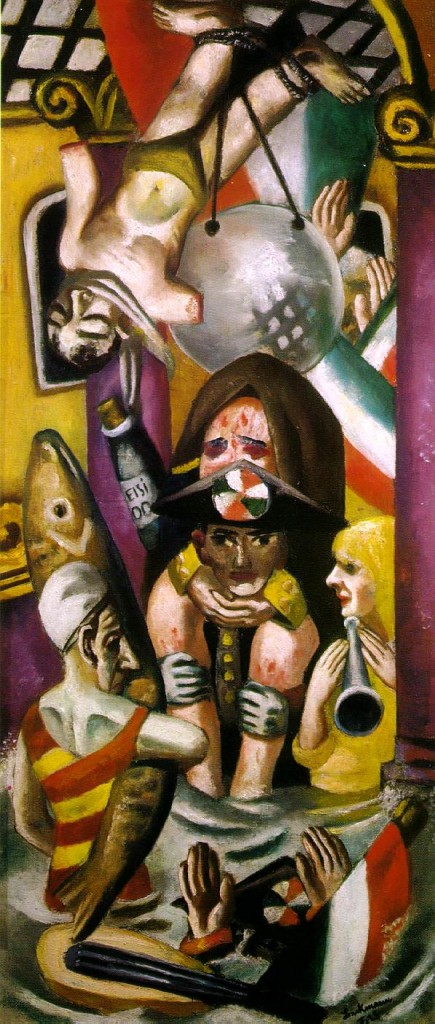
---We know that Mussolini was killed on April 28, 1945, by Italian partisans, and subsequently hung by his feet in the Piazzale Loreto in Milan. However, this scene was painted by Beckmann twenty years before Mussolini's death! Erhard Göpel, an art critic who often visited Beckmann in his exile in wartime Amsterdam, gives the following account: "When, in 1925, he promenaded through the Galleria Umberto in Naples, he saw the flood of fascism rising, he saw carabinieri saving drowning people and a body hung upside down by ropes. He saw this in broad daylight. When Mussolini's fall was reported, he fetched the painting from the closet and showed it in his studio. He considered it a vision even before he knew that he had also foreseen the manner of the dictator's end hanging head down."---
Different diseases may show the same symptoms. To insist that the analogy between Germany in the 1920’s and America of the twenty-first century is mainly an analogy, interesting, but in few respects helpful- permitting us neither to understand the one nor to rescue the other- is not to dent that America is sick. It is to insist that the two sicknesses are are probably different.
When talking about things like the “German mentality” or general “feelings” in Germany, it should not be implied that those feelings or beliefs were shared by the whole German population. It is clear that a population of more than sixty million people is not a homogenous body. Especially during the time of the Weimar Republic, the German population was highly polarized.

Ludwig Meidner. Apocalyptic landscape. 1912. Many university professors beleived that democracy was an essentially non German form of political organization, suitable for the materialistic Anglo-Saxons but incompatible with the idealism of the German race.
The outbreak of the First World War was warmly welcomed in Germany. Germans from all political arenas and levels of education believed that German superiority would win a war. When the war was lost after four years of hard fight, and a peace treaty was planned, Germans believed they would be treated fairly. The loss of the war left Germany in deep despair. Many Germans could not believe that the war was lost, because the war propaganda had painted an image of a strong, victorious Reichswehr. The signing of the armistice and the abdication of the Kaiser shocked the German public. The end of the monarchy was perceived by many Germans as the collapse of a whole world, as a breakdown of fundamenals and burst opening of dams, on and in which the nation used to live and find its political form and culture.
Germany descended into chaos, both physically and mentally. With the abdication of the Kaiser, left-wing workers’ and soldiers’ councils attempted a revolution, which was fought against by right-wing freecorps. At the same time, soldiers were flooding back into the country, their four years of absence from civil life resulted in integration problems. Having to face the reality of a lost war and a destroyed country, or the fact that a system they believed in had let the promising youth be killed on the battlefields of the First World War, many people looked for models for future development. The one power that could best suit as such a model was the USA.

"In the early 1930s Herbert von Reyl-Hanisch intensified his criticism of civilization. He regarded industrialization as the destroyer of humane values and promoter of aggression and aimed to hold up the classical ideal as a contrast to this, as a kind of purification for the soul. The fighter on the left, who steps forward boldly, while his opponent with a knife adopts a defensive pose. The woman, whose presence suggests that she is the reason for the duel, is watching the scene with cool composure. In a preparatory drawing at the Vorarlberger Landesmuseum in Bregenz, the man on the right is shown in bourgeois attire, creating a greater contrast with his opponent who looks more like a worke. "
In contrast to the American political inactivity, their economic power was felt everywhere, as was American culture. In 1923, the United States produced 49% of all products worldwide. In the years between 1919 and 1927, the American economy grew ten times as fast as in the years of 1900-1919. It is no wonder that this economic success attracted attention from other nations. The German public, dominated by middle class and intellectuals, never tired of praising the American accomplishments in economic issues. Even those from a socialist background, such as the Social Democrats and unionists saw the United States as a model for future German development. The US capitalist system seemed to create a population without the polarization into extreme left and right wings that was present throughout the whole Weimar Republic. Not only did it provide a solution for economical problems, but it also solved political problems.
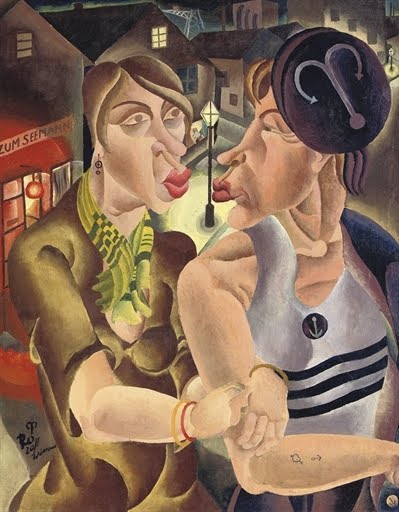
Marcel Ronay, 1929. Student extremism took many forms in Weimar Germany. Most students agreed only on what they detested: socialism, equality, republicanism, Jews. In their hunger for certainty, the swallowed the novels of Ernst Junger, who celebrated war as a glorious experience, or the plays of those among the expressionists who preached violence, as an essential explosion of one's feelings.
The American economy was highly impressive to the Germans of the time. American practices which were believed to improve the economy streamed into Europe. The US was seen as a land of rationalisation and pragmatism. Two concepts were applied, Taylorism and Fordism. Another expression for Taylorism is “scientific management”. Frederik Taylor, an engineer in the “Midvale Steel Company”, invented this kind of management even before the First World War. The kernel of his program was the division of labour in hundreds or thousands of exactly calculated small steps. This rationalisation was made possible by a scientification of management and produ
n. The elimination of all useless steps led to an increase in production by forty times.Fordism was invented by Henry C. Ford. His use of the assembly line in the production of his famous “Model T” car made it possible for him to produce fast and cheap automobiles in high numbers. American culture spread over Europe in different ways. Indirectly, the economic influence brought with it American goods and mass-consumerism mentality. More directly, American culture came with American soldiers during the First World War, who were in the western European countries of Britain, France, and Belgium. Their presence also affected the people in Germany. The high American cultural influence on Europe after the Second World War can be explained with the stationing of large contingents of American troops in Europe until long after the war was over.
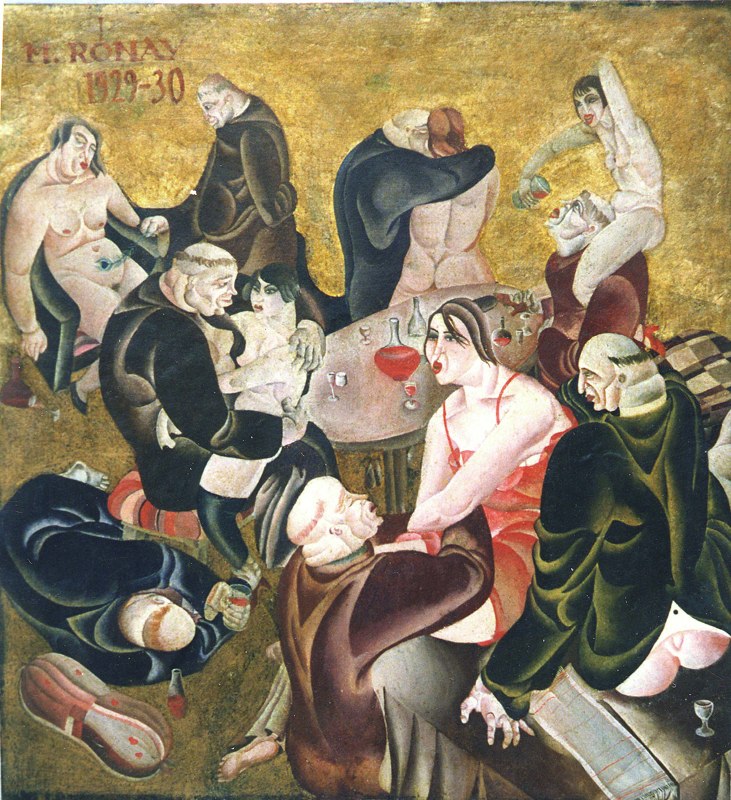
Ronay . Nuns 1929. In the long run, and in view of their fate, the German university youth in their social and economic conservatism, and pathetic anti-intellectualism; arouse pity. They went to their deaths with incomprehensible verses or swinish slogans on their lips, corrupted by those who should have enlightened them.
The American cultural idea was also the outcome of the German feelings described above. Broadly speaking, both conservative and cultural progressive streams had the same origins with regard to these feelings. For the more conservative people, the collapse of the old Reich and the monarchy was the collapse of a world, as previously stated, and they used it as a starting point for the desire to restore that old world or at least parts of it. For them, the experience of the revolutionary conditions of 1918/19 was a trauma that included not only the extreme left but also the moderates and later the democrats in general. For the more progressive and also younger people, the downfall of the old monarchic system created possibilities and the energy to create something new, oriented towards American influences. The end of the war created euphoria in Europe, which was reflected in a desire for the modern and the new.
One of the major American influence in Europe, and particularly in Germany, was jazz. Jazz came to Britain in 1919 as what was later called Dixieland-Jazz, played by whites. The development of jazz “confirmed America as the source of new popular music in the developing urban age.” In their critiques, jazz was contemptuously dismissed by the musical establishment as “jungle music.” Jazz dances such as the Charleston and Rumba were also perceived as exotic or African. Josephine Baker became an example of the symbol for the sensuality of the new dance. Another is this citation of a young woman from Berlin about Rumba: “and if you repeat ‘Rumba’ quickly, sometimes you can imagine those grinning negroes playing drums with their hands.” In the same context, German conservative papers -who under almost a monopoly of Alfred Hugenberg, the later chief of the national conservative party, controlled more than two thirds of the market- complained about the “contamination of the German youth” by “alien Niggerjazz and jungle dances”, which inevitably would lead to “racial disgrace” and thus to the end.

"In 1919 Jeanne Mammen and her sister Marie Louise moved into a former photographic studio at Kurfürstendamm 29. Jeanne Mammen called this green oasis in the heart of Berlin her garden, and it was to become her residence and studio for 57 years, until her death in 1976. The years from 1924 to 1934 can be dated as her realistic period, and almost all satirical journals and popular periodicals of that time displayed her watercolours and drawings, with scenes portraying the atmosphere typical of life in Berlin, both by day and by night. As of 1927 she had succeeded in supporting herself on the income from her art work."
The rise of the “Comedian Harmonists” serves as a good example for the American influence on Weimar German culture. It is an example for the introduction of a new style of music and the German adaption and advancement of those influences. The Comedian Harmonists were an a-capella band consisting of five singers and a pianist, and are to be counted among the most famous musicians of the Weimar Republic. Their fame in Germany was only later equalled by the Beatles, but never before and after that there was such a “hype” of a German band in Germany. The Comedian Harmonists were founded by Harry Frommermann in Berlin in 1927, after the example of the American band “The Revelers” . The Revelers were an American a-capella-band consisting of four singers and one pianist founded in 1917. They used to make more convential music and had successful gigs on stage and in the recently invented radio, but in 1925 their frontman Wilfred Glenn decided to change their style and try something new – to employ jazz. The result was something thrilling for America: a-capella jazz was an absolute Novum. The relaxed style of singing with the use of jazzy sound effects was strongly appreciated by audience on both sides of the Atlantic.
In 1925, the record company Electrola published the first records of the Revelers in Germany. The music was indicated as “Negergesang”, “Negroe’s singing”, due to the unconventional Jazz style. Harry Frommermann felt their singing as something revolutionary and new. His fascination with the appearance of the Revelers resulted from the fact that not every singer wanted to give a single expression, but that the voices worked together and achieved one sound. As he put it, “it was not only their style, but the joy of singing emitted by their records.” This joy of singing can referred to what was mentioned above: Americans were generally seen as more optimistic people. Furthermore, inventing an unconventional style, work with precision, charm and ideas can be seen as an example of what Germans admired at Americans. In contrast to that, German vocal music was sensed as stiff, lacking rhythm and “having seething beards”.
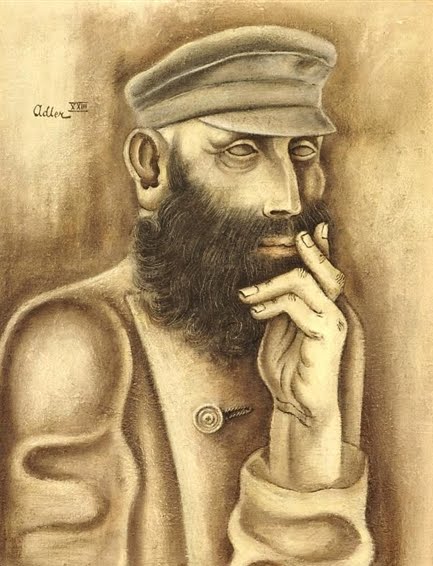
"Jankel Adler (1895-1949) was born as the seventh of ten children near Lodz, Poland. He grew up among hassic Jews surrounding the textile city of Lodz, influenced greatly by its Polish, German and Jewish population. Adler started an apprenticeship as an engraver with his uncle in Belgrade in 1912, after which he traveled through the Balkan countries. During World War I, as a "suspicious foreigner" Adler commenced his studies with Professor Gustav Wiethüchter at the Kunstgewerbeschule in Barmen, Germany."
The foundation of the Comedian Harmonists was at first supposed to imitate the American model. The German press perceived them as a somewhat American phenomenon. In a critique in “Die Frechheit”, a supplement to the program of a cabaret, the authour wrote: “Gosh, they sound like a refined version of the Revelers. If those boys came from America, they would be a sensation in Berlin.” With the time the ensemble developed their own style – they were not as focused on jazz as the Revelers were, but also had the ability to intonate music of a range from arias from Rossini’s “Barber of Seville” to German folksongs, “from Brahms to Blues”. But still, among the most loved songs from the Comedian Harmonists was the “Creole Love Call”, a song without text, only with the five voices imitating a Jazz-orchestra. Another song refered to Rumba – its title (repeated over and over again) neatly exemplifies the above mentioned statement by the Berlin woman: “Mein Onkel Bumba aus Kalumba tanzt nur Rumba.”
In addition to all this, the Comedian Harmonists can alse be a symbol for America. The Comedian Harmonists were a figure for multiculturalism:- of the six members of the group, three were Jews, three were Christians. Four were Germans, one was Bulgarian, one Polish. The story of success of the Comedian Harmonists was in fact an American story of success – “from rags to riches”. A story of poor people, except for the pianist, Erwin Bootz, who had comparatively rich parents, some of foreign origin and not all being able to speak proper German, who became one of the most celebrated stars of interwar Germany.
As a side note, the end of the Comedian Harmonists was not American at all. The band was forced by the Nazis to break up in 1935, and the Jewish members of the group had to emigrate from Germany. Despite their political isolationism, the United States was economically the most powerful country in the world. Culturally, the jazz movement infiltrated Europe on the coat-strings of American economic supremacy on the depressed continent. These facts account for the strong identification with American ideals in the Weimer Republic inbetween the two World Wars.
ADDENDUM:
In today’s New York Times,( Sep. 1o. ) Paul Krugman writes of the ever-increasing slide toward what he views as a Latin America “banana republic.” There is much to his analysis, but let me suggest that we are better advised to look at Weimar Germany during the 1920s (rather than, say, contemporary Mexico or Argentina) to understand our present political situation.
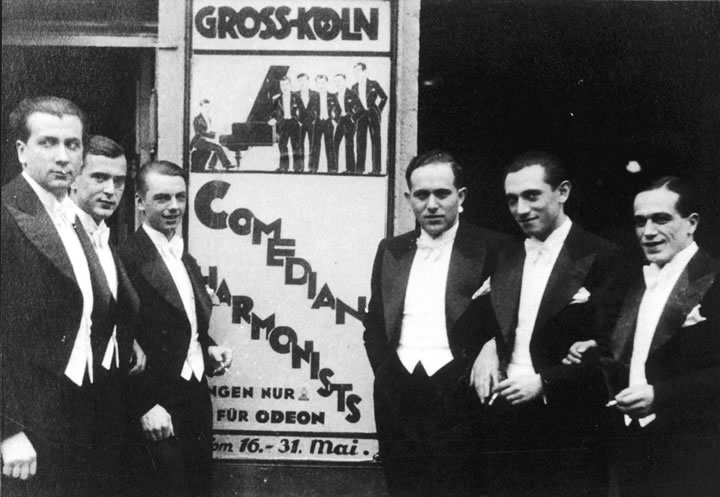
Wiki:The group's success continued into the early 1930s, but eventually ran into trouble with the Nazi regime: three of the group members - Frommermann, Collin, and Cycowski - were either Jewish or of Jewish descent, and Bootz had married a Jewish woman. The Nazis progressively made the group's professional life more difficult, initially banning pieces by Jewish composers, and finally prohibiting them from performing in public.
Begin with the fact that more and more people, regardless of political party identification, have altogether justified contempt for Congress as an institution. When I last checked, the Gallup poll showed that a grand total of 19% of the America public “approved” of Congress, while a full 75% disapproved. …. I began touting Carl Schmitt’s incisive (and altogether depressing) analysis of the Wemar Parliament several years ago; if anything, he’s even more on the mark now than then.
…The lack of confidence in the economy, and the overall misery that this produced, meant that the German reaction to the Great Depression that arrived six years later was much more extreme than in the United States – leading to the election in 1933 of Adolf Hitler.The current policy mix reflects those of Germany during the period between 1919 and 1923. The Weimar government was unwilling to raise taxes to fund post-war reconstruction and war-reparations payments, and so it ran large budget deficits. It kept interest rates far below inflation, expanding money supply rapidly and raising 50% of government spending through seigniorage (printing money and living off the profits from issuing it).
Even John Maynard Keynes, no monetarist, recognized the problems with this, stating in his 1920 treatise the “Economic Consequences of the Peace” that “the inflationism of the currency systems of Europe has proceeded to extraordinary lengths. The various belligerent Governments, unable, or too timid or too short-sighted to secure from loans or taxes the resources they required, have printed notes for the balance.” The really chilling parallel is that the United States, Britain and Japan have now taken to funding their budget deficits through seigniorage.


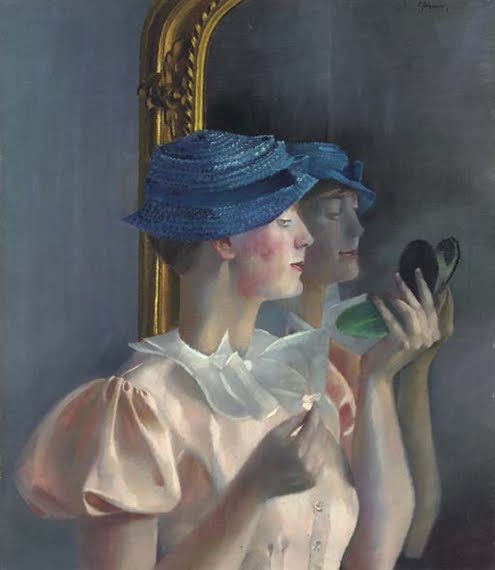



 COMMENTS
COMMENTS